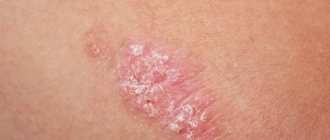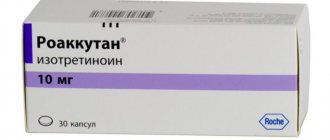Sudden exanthema
The incubation period for sudden exanthema ranges from 5 to 15 days. The disease begins with a sudden increase in body temperature to high values (39-40.5°C). The period of fever lasts for 3 days, accompanied by severe intoxication syndrome (weakness, apathy, lack of appetite, nausea).
It is characteristic that with sudden exanthema, despite such a high temperature, in most cases there are no catarrhal symptoms (runny nose, cough). Relatively rarely, younger children experience diarrhea, nasal congestion, enlarged cervical lymph nodes, swelling of the eyelids, hyperemia of the pharynx, and a small rash on the soft palate and uvula. In infants, pulsation of the fontanel is sometimes observed.
Body temperature decreases slightly in the morning; While taking antipyretics, children feel satisfactory. Since sudden exanthema coincides with teething, parents often explain the increased temperature precisely by this fact. Sometimes, with a sharp increase in temperature to 40°C and above, febrile convulsions develop: with sudden exanthema, they occur in 5-35% of children aged 18 months to 3 years. Febrile seizures are usually not dangerous and go away on their own; they are not associated with damage to the nervous system.
A critical decrease in temperature with sudden exanthema occurs on the 4th day. Normalizing the temperature creates a false impression that the child has completely recovered, but almost simultaneously, a pinpoint or small-spotted pink rash appears all over the body. The rash first appears on the back and abdomen, then quickly spreads to the chest, face and limbs. Elements of the rash with sudden exanthema are roseolous, macular or maculopapular in nature; pink color, diameter up to 1-5 mm; when pressed they turn pale, do not tend to merge and do not itch. The rash that accompanies sudden exanthema is not contagious. During the period of rashes, the child’s general well-being does not suffer. Skin manifestations disappear without a trace after 2-4 days. In some cases, sudden exanthema may occur without a rash, only with a febrile period.
Complications from sudden exanthema develop quite rarely and, mainly, in children with reduced immunity. Cases of the development of acute myocarditis, meningoencephalitis, cranial polyneuritis, reactive hepatitis, intussusception, and post-infectious asthenia have been described. It has been noted that after suffering a sudden exanthema, children may experience accelerated growth of adenoids and frequent colds.
General information
Exanthema (rash) is a reaction of the skin and mucous membranes (in this case we speak of enanthema) to the action of microbes or viruses.
It has different shapes, sizes and accompanies many diseases. Currently, infectious exanthemas (or another name - viral exanthemas) are combined into a group of viral infections, which at a certain stage manifest themselves as a rash. The infectious nature is supported by an acute onset, intoxication, temperature, the cyclical nature of the process, and the presence of characteristic signs for a particular infectious disease.
The difficulty is that for correct diagnosis, and therefore treatment, it is important to know the differential signs of exanthema that distinguish one disease from another. If measles, rubella, infectious mononucleosis, chickenpox are accompanied by exanthema as an obligatory component of the clinical picture of this disease, then with other viral infections the rash is unstable and changeable. Therefore, these infections often remain unrecognized, and the appearance of a rash is regarded as a manifestation of urticaria , atopic dermatitis or an allergic reaction to medications.
Viral exanthema on the body indicates the systemic spread of the pathogen. An important sign is that the viral rash is rarely localized to the palms and plantar surfaces (with the exception of some infections). Exanthema often coexists with enanthema (rash on the mucous membrane), with the latter appearing 1-2 days earlier. Some signs of viral replication in the mucous membranes of the mouth help in making a diagnosis. With herpangina (an infection caused by the Coxsackie A virus), ulcers appear on the mucous membrane of the tonsil arches and uvula, with measles - Koplik-Filatov spots, and petechiae on the palate with infectious mononucleosis. Even with careful examination, about 50% of infectious exanthems remain unspecified.
Consequences and complications
The outcome of the disease depends on the severity of the infection. With mild to moderate severity of enteroviral infections, the disease ends with complete recovery with the formation of serospecific immunity. The rash disappears without a trace and no skin complications are observed.
Complications in severe cases are associated with damage to the nervous system:
- meninitis , encephalitis ;
- cerebral edema
- convulsive syndrome;
- paralysis;
- epilepsy;
- deterioration of hearing and vision.
Meningoencephalitis is typical of parvovirus B19 and enteroviruses. Pleurisy and carditis are mostly observed with Coxsackie B infection. The HHV-6 virus can cause fulminant hepatitis and Rosai-Dorfman syndrome (generalized lymphadenopathy).
Tests and diagnostics
Diagnosis is complex and includes epidemiological history data, taking into account the symptoms of the disease and laboratory confirmation. To establish a diagnosis, information about contacts with infectious patients in any group and at home is important. In this case, the duration of the incubation period is taken into account, the dynamics of the appearance of the rash and its changes during the course of the disease are determined.
An objective examination takes into account the characteristics of the rash:
- shape of elements;
- quantity (abundant, sparse, single);
- localization;
- color and tendency to merge;
- appearance dates and order;
- evolution (dynamics);
- presence or absence of itching;
- outcome of the rash (disappearance without a trace, crusts, scars, peeling).
Some infections (for example, roseola infantum , measles , rubella , hand-foot-mouth disease ) do not cause diagnostic difficulties and the diagnosis is established on the basis of typical clinical manifestations. However, it is better to carry out specific diagnostics. Taking into account age criteria, children under 1 year of age should first of all be examined for HHV6 infection, and children over 3 years of age for parvovirus infection. Enterovirus infections occur in children of all age groups.
For diagnostics the following are used:
- Virological method of isolating a virus from biological materials and cultivating it in cell culture. The method requires more time to make a diagnosis.
- The ELISA method determines specific antibodies IgM, IgA, IgG to the HHV-6 virus or enteroviruses. Early markers include IgM titer. IgG appears later. The study of paired sera over time and a 4-fold increase in antibody titer confirm the diagnosis. The first blood test is taken no earlier than 5 days of illness. Reinfection is indicated by the detection in the early stages of the disease of not only specific IgM antibodies, but also IgG antibodies.
- The use of PCR, which detects the virus in tissues (blood, feces, saliva, nasopharyngeal washes, vesicular discharge). Sample collection is carried out under sterile conditions in the first 3 days of illness. Detection of DNA or RNA viruses (depending on the identity of the viruses) by PCR is a more sensitive method for diagnosing a primary infection. Reverse transcriptase PCR reliably differentiates any latent viral infection.
- General clinical blood tests. With roseola in infants, leukopenia , neutropenia and thrombocytopenia , the number of lymphocytes increases, and atypical mononuclear cells may appear. For many viral diseases, a lymphocytic reaction is inherent, but the most distinct one is with mononucleosis , rubella , and measles .
Diet
Diet 15 table
- Efficacy: therapeutic effect after 2 weeks
- Timing: constantly
- Cost of food: 1600-1800 rubles per week
This group of diseases does not require a special diet and Diet 15 table . In case of diarrhea, which sometimes accompanies an infection, patients are prescribed a gentle diet: pureed soups, boiled porridges, steamed omelettes, chopped boiled meat. It is necessary to pay attention to the patient's compliance with the drinking regime (1.5-2 liters depending on age). Drinking plenty of fluids reduces intoxication syndrome, helps lower the temperature and facilitates the course of the disease.
List of sources
- Bystryakova L.V. Infectious exanthemas in children. L.: Medicine. 1982. 216 s
- Zubik T.M., Ivanov K.S., Kazantsev A.P. Differential diagnosis of infectious diseases. Guide for doctors. - L.: Medicine, 1991. - 336 p.
- Anokhin V.A., Sabitova A.M., Kravchenko I.E., Martynova T.M. Enterovirus infections: modern features // Practical medicine. Pediatrics. — No. 9 (85). - 2014. - pp. 52-59. 7.
- Peter G. Heger: Pediatric dermatology. Differential diagnosis and treatment in children and adolescents. 2013; 410-427.
- Drozdov V.N., Novikov A.I., Obert A.S., Belan Yu.B. Exanthematous infections in children. Lectures for intern doctors. - M.: Medical book, 2005. - 217 p.
Prevention
Since the creation of a vaccine against enterovirus infection is impossible due to the many serotypes of viruses, disease prevention consists of following the rules of personal hygiene:
- Use boiled or bottled water for drinking.
- Wash your hands after visiting the toilet and before eating.
- During the day, you should use antiseptic wipes as often as possible to prevent the virus from entering through dirty hands.
- Treating dishes and children's toys with hot water.
- Eating thoroughly washed raw fruits, vegetables and berries, if possible, treating them with boiling water. You can also use the Aquatabs disinfectant. Fruits and vegetables are immersed in a solution containing 0.004% active chlorine for 30 minutes. To obtain such a solution, take 1 tablet of the drug with a dose of 500 mg per 7.5 liters of water. After time, the fruits and vegetables are dried.
- Beware of swimming in bodies of water, try not to swallow water, and after swimming, wash your face and hands with clean water.
A set of preventive measures in children's groups includes identifying patients - sources of infection and their isolation. Disinfection is carried out in preschool institutions.
Specific prevention (vaccination) is available only for measles and rubella. Vaccination against measles is carried out with live measles vaccine in a planned manner: once every 12 months and revaccination at 6 years. Mono-vaccines against rubella are registered in Russia: Rudivax (France), rubella vaccine , and combined measles-mumps-rubella vaccine. In 2021, the first domestically produced vaccine in Russia against measles, rubella and mumps passed clinical trials. It will soon appear on the pharmaceutical market. The multicomponent vaccine is easier to tolerate, and the frequency of side effects is the same.
Vaccination of contact persons. Administration of measles vaccine up to 72 hours after contact with a sick person protects against the disease. Administration of the rubella vaccine does not prevent the disease. If a pregnant woman comes into contact with a person with rubella, administration of immunoglobulin is indicated if she does not want to terminate the pregnancy after proven infection.
Treatment of allergic rashes in Samara
MK "Clinic 4 Management" offers the services of an allergist-immunologist to everyone who is faced with the manifestation of an allergic rash. Our experienced and highly qualified specialists will help you find the cause and get rid of the problem. The consultation is conducted by an allergist-immunologist with many years of experience. Prices for services:
| Name of service | Price |
| Initial consultation | 1800 rub. |
| Repeated consultation | 1200 rub. |
- You can ask questions or make an appointment by calling:
- + (reception).
Allergists-immunologists conducting appointments - see the Specialists section.
Non-infectious causes of rash:
- allergies, for example, to medications (including such dangerous forms as urticaria and erythema multiforme);
- autoimmune diseases (rheumatic arthritis, systemic lupus erythematosus...);
- blood diseases;
- and many other reasons.
A rash, especially if it appears suddenly and is accompanied by other serious symptoms (fever, pain, itching, nausea and vomiting, deterioration in general health) requires immediate medical attention.
A little about us
Eurpomed Kids are two children's clinics (in the north and south of the city), each of which has all the necessary specialists, including pediatric dentists, as well as its own laboratories and on-site pediatric service. To ensure that children grow up healthy, we work seven days a week from 9 to 22:00! We tell you more about why Euromed Kids clinics are the best here










